What to Expect When Pursuing a Personal Training Certification
Becoming a certified personal trainer is a rewarding way to turn your passion for fitness into a career. Whether you want to work in a gym, build your own client base, or specialize in a niche area of health and wellness, a Personal Training Certification provides the foundation you need. It proves your knowledge, builds client trust, and opens the door to professional opportunities.

This guide explains how to choose the right program, prepare for the exam, strengthen your knowledge of anatomy, gain practical skills, and continue developing your career through ongoing education.
Choosing the Right Certification Program
The first step is selecting a program that fits your goals. Not all certifications carry the same recognition, so it’s important to look for those accredited by respected bodies such as the National Commission for Certifying Agencies (NCCA) or the Distance Education Accrediting Commission (DEAC).
Some of the most recognized options include:
- NASM (National Academy of Sports Medicine)
- ACE (American Council on Exercise)
- NSCA (National Strength and Conditioning Association)
- ISSA (International Sports Sciences Association)
- ACSM (American College of Sports Medicine)
Each organization has strengths. NASM is highly regarded for corrective exercise, while NSCA is known for strength and conditioning. Compare costs, study resources, and continuing education requirements to find the best fit for your career path and budget.
Study Methods and Preparations
Once you’ve selected a Personal Training Certification, it’s time to prepare. Success requires more than memorizing definitions—it’s about understanding concepts and knowing how to apply them.
Effective study methods include:
- Create a Study Schedule – Break material into manageable sections and review consistently.
- Use Multiple Learning Tools – Mix textbooks with videos, flashcards, and online resources.
- Study with Others – A group can help you stay accountable and clarify difficult topics.
- Take Practice Exams – Simulating test conditions builds confidence and highlights areas for improvement.
Most candidates spend two to four months preparing. If you’re balancing a busy schedule, spread your study sessions out over evenings and weekends to avoid last-minute cramming.
Know Anatomy and Physiology
A strong understanding of anatomy and physiology is essential for earning your Personal Training Certification. These subjects are at the core of safe, effective program design.
Focus on:
- Muscular System – Learn major muscle groups and their functions.
- Skeletal System – Understand movement patterns, joints, and injury prevention.
- Cardiovascular and Respiratory Systems – Know how the body supplies oxygen and energy during exercise.
- Energy Systems – Recognize how the body fuels both strength and endurance training.
Explaining the “why” behind an exercise helps clients stay motivated and trust your expertise. If the material feels overwhelming, use visual aids like anatomy apps or 3D models to make learning more interactive.
The Certification Exam
The exam is the final hurdle before becoming certified. Most are computer-based and include multiple-choice questions, case studies, and applied scenarios.
Typical exam details:
- Length – Around 100–150 questions
- Time Limit – Two to three hours
- Passing Score – Usually about 70%
- Subjects Covered – Anatomy, exercise science, program design, client consultation, and safety
To improve your results:
- Review the content outline provided by your organization.
- Take several timed practice tests.
- Focus on applying knowledge to real-life examples rather than memorizing facts.
- Arrive rested and prepared on exam day.
It’s not uncommon to need more than one attempt. Each try strengthens your understanding, so persistence is key.
Gaining Practical Experience
Earning your Personal Training Certification is only the beginning. Employers and clients value hands-on skills just as much as knowledge.
Ways to gain experience include:
- Internships at gyms or studios
- Shadowing experienced trainers to see how they coach clients
- Working with friends or family to practice designing and delivering programs
- Part-time positions in fitness facilities to build confidence
Communication is just as important as exercise knowledge. Trainers succeed not only by writing effective programs but also by motivating, encouraging, and adapting to their clients’ needs.
Continuing Education and Specializations
Certification is the first step in a career-long process. Most organizations require continuing education credits every two to three years, ensuring trainers keep up with new research and trends.
Options for growth include:
- Workshops and online courses to stay current with best practices
- Specializations such as nutrition, corrective exercise, group training, or sports performance
- Advanced education in exercise science or kinesiology
- Additional certifications in CPR, first aid, or sport-specific training
Pursuing a specialization helps you stand out. For example, expertise in prenatal training or athletic performance can attract clients looking for tailored support. Continuing education not only maintains your credential but also increases your value as a professional.
Final Thoughts
A Personal Training Certification is more than just a qualification—it’s the start of a meaningful career in fitness. Choosing a program that matches your goals, preparing thoroughly, mastering anatomy, and gaining practical experience are all essential steps. Continuing education then ensures you stay competitive as the industry evolves.
Whether you dream of working in a gym, coaching athletes, or building your own training business, certification provides the knowledge and credibility to succeed. With dedication and commitment, you’ll be ready to inspire others and guide them toward healthier, stronger lives.






